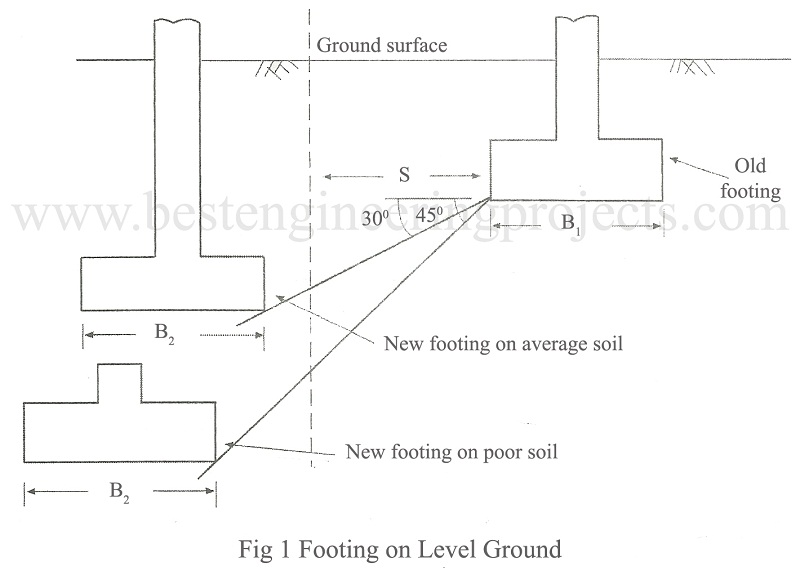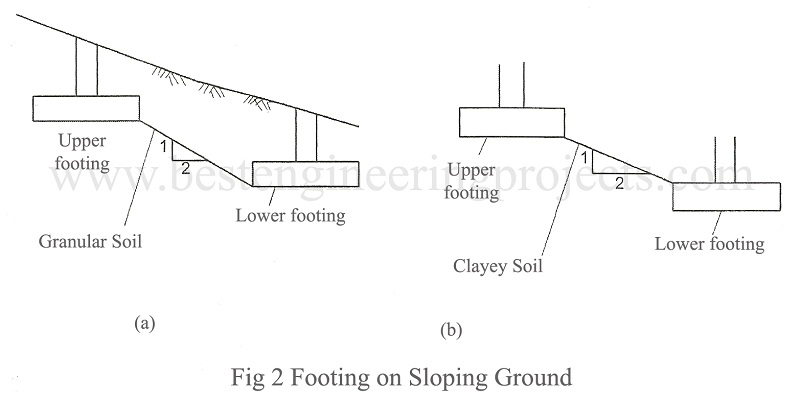What is Foundation Depth?
A foundation should be provided with adequate depth so that it functions properly. The factors that govern the foundation depth are:
- Depth of top soil
- Local erosion of soil due to flowing water
- Underground defects such as root holes, cavities, mine shafts etc
- Filled unconsolidated soil
- Adjacent structures, property lines, excavation and future construction operation
- Ground water level
- Depth of frost penetration
- Depth of volume change
- Desiccation due to heat of boilers and furnaces
- Desiccation due to water drawn by roots of trees
Depth of top soil | Foundation Depth | Factor of Foundation Depth
The footing should be located below the top soil consisting of organic matters, which is likely to decompose eventually.
Local erosion | Foundation Depth | Factor of Foundation Depth
This is particularly important in hilly area where the rainfall is heavy. The soil in such situation is likely to wash away to a considerable depth. The foundation should be placed below the zone of local erosion.
Underground defects | Foundation Depth | Factor of Foundation Depth
If some underground defects are suspected in an area, it should be investigated well in advance of the construction of foundation. No footing should be located above the underground defects like root holes, cavities, buried old vaults, mining shafts, old wells, sewers, cables etc.
Unconsolidated filled up soil | Foundation Depth | Factor of Foundation Depth
Man made or other kinds of fills are under-consolidated and they have not attained full shear strength. If foundation is laid on such soils they undergo large total and differential settlements leading to severe damage or even collapse of the structures. Before deciding the depth of foundation in such soil, the strength characteristics should be thoroughly assessed.
Footing on the level ground | Foundation Depth | Factor of Foundation Depth
The footing should be so located that no damage is done to the existing structure. The damage to the old footing could be due to shocks, vibration, undermining of soil beneath the footing of old foundation and lowering of the water table. In such case new footing should be kept sufficiently away from the old. The foundation arrangement should be made as shown in Fig.1 below in the horizontal plane. The adjacent edge of new footing must be at least at a distance ‘S’ from the edge of existing footing and ‘S’ should be greater than the width of the larger footing. Further, in order to avoid interference, the minimum horizontal distance ‘S’ should be greater than the difference in elevation between the adjacent footings.
Footing on sloping ground – For footing on granular soil, the line joining the lower adjacent edges of footings should not have a slope steeper than two horizontal to one vertical as shown in Fig.2. In clay soils, the slope of the line joining the lower adjacent edge of the upper footing and upper adjacent edge of the lower should not be steeper than two horizontal to one Vertical.
Ground water level – As far as possible, footings are to be placed above the ground water table. Presence of water table may create some problem to the foundation. If depth of foundation is to be provided below water table, quick sand condition often create problem. Water table drastically reduces the soil supporting power. Drainage of basement floors, water proofing of basement, resistance against uplift pressure become serious considerations.
Frost action – The footing should be carried below the depth of frost penetration. If footing is placed at insufficient depth, it will be subjected to frost damage due to formation of ice lenses and consequent frost heave. Due to frost heave, footing is lifted and gets settled down when thawing takes place. During this process, there will be a significant reduction in the shear strength of the soil and damage to the foundation. To prevent from frost damage, the footing should be placed below the frost depth, which could be 1 m or more depending upon the severity of coldness.
Depth of volume change – Especially clay soils of high plasticity undergo large change in volume during wetting and drying. They shrink upon drying and swell during Wetting. The volume changes are generally greater near the ground surfaces and decrease with the increasing depth. Significant volume change under a footing may cause alternate lifting and dropping. The footing should be placed below the soil strata susceptible to large volume changes.
Desiccation due to heat – Desiccation is the shrinking of soils due to removal of moisture from the soils. It causes severe settlement of structures. Desiccation occurs in soils located close to the plants like boilers, ovens, and furnaces etc, which are not insulated adequately from ground. Heat from sun also causes desiccation and soil like silts and clays are particularly vulnerable to this phenomenon. These soils become very soft when subjected to water during rainy season.
Desiccation due to roots – Desiccation can also occur in soils located close to the large trees or shrubs. These trees remove moisture from soils and cause soils to desiccate. As a result, large settlement can occur in structures located close to the root system of such trees. It is therefore essential that such trees are to be removed from the construction site.
Scour – Scouring cause’s severe damage to the structures located close to the rivers. In such case, foundation should be placed to such depth that the effect of scouring would not have any influence to the structure.

